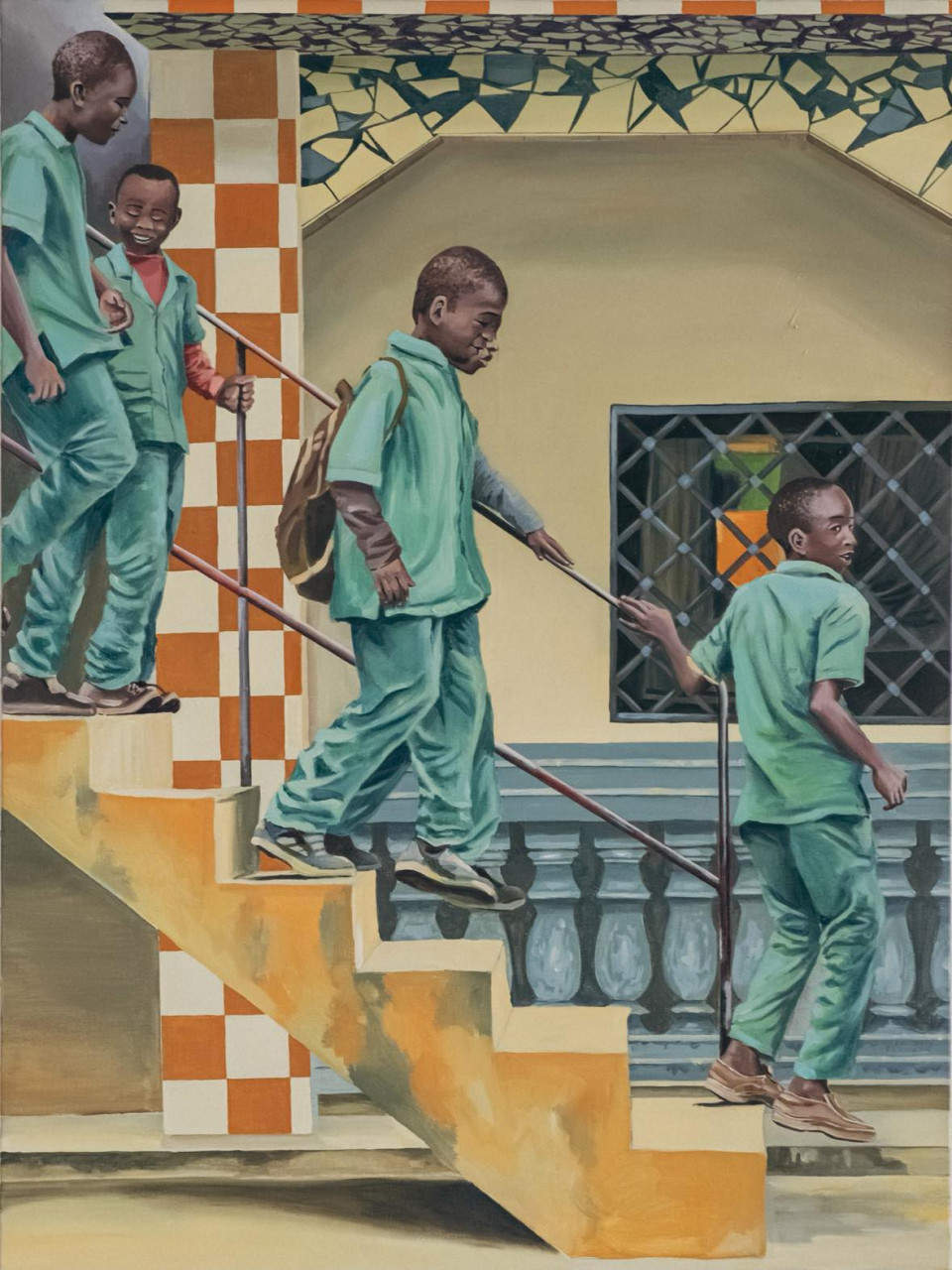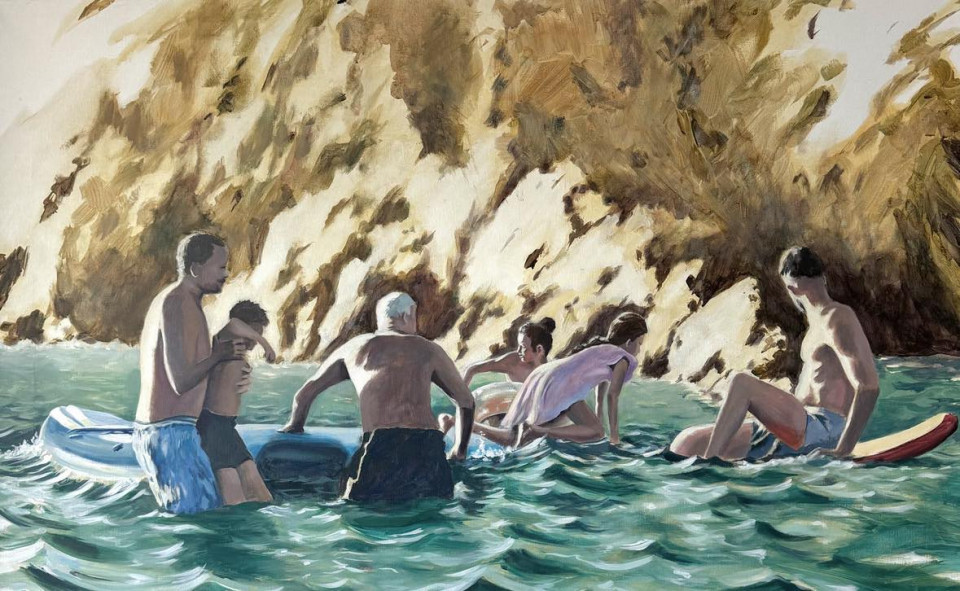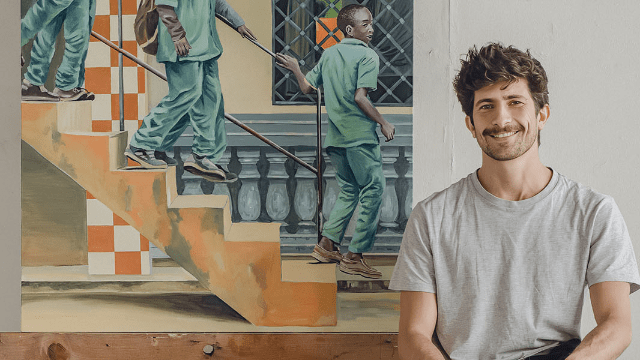Matthieu Delfini (E16): "After a Career in Finance, I Ended up Painting"
5 years ago, Matthieu Delfini (E16) had never touched a paintbrush before. Today, he makes a living from his art and has left his career in finance. A self-taught success, as confirmed by an exhibition at La Samaritaine (Paris) opening on 2 July.
ESSEC Alumni: How did you go from ESSEC to artist?
Matthieu Delfini: In November 2019, I fractured my kneecap. Forced to stay at home, I kept myself busy by trying my hand at painting, using materials my friends gave me. It was a revelation: the exercise was very intuitive for me, getting a grasp on texture, blends and colours, but also drawing, relationships of scale and perspective. I had to practice a lot to progress, but after overcoming my personal obstacles, the machine is up and running. After three years, I decided to leave my job in finance – to tell you the truth, I never really felt at home behind a desk – and embarked on a career as a painter.
EA: How did you reach this professional level?
M. Delfini: I’m completely self-taught, I haven’t taken any classes or tutorials. I believe in the power of intuition, and above all, as a figurative painter, in the power of observation and practice. I spent long hours, tirelessly, observing the sea, vegetation, nature, and created portraits of friends, loved ones, strangers, simply by striving to reproduce what I saw – that was how I trained myself. Doing, redoing and redoing again. My notebooks come with me on all my travels and allow me to draw or paint anywhere, and to try out every technique: watercolour, gouache, ink and pencil. These small-format experiments often lead to large-format acrylic paintings on canvas.
EA: Why did you decide to devote yourself full-time to art – rather than continuing to work in the business world at the same time?
M. Delfini: At first, I thought of it as a hobby, but painting has become a daily need, a way of being in the world. Now, it would be impossible for me to devote only half my time to it. I can't help it: I have to give it a go and have no regrets. Painting allows me to buy myself a form of freedom.
EA: How would you define your work today?
M. Delfini: My artistic work is based on research into interior and exterior spaces, and the relationships that individuals have with themselves, with others and with the world around them. I began by exploring landscapes, sometimes imaginary, sometimes real, particularly those in my native south: seas, mountains, fields, cliffs – calm horizons, bathed in vibrant colours, that spark emotion and invite contemplation, meditation, reflection and escape... A world bordering on the dreamlike. Then my attention turned to human beings and scenes from everyday life, to movements, stances and looks, all silent micro-expressions that tell stories and convey what cannot always be said with words. This two-pronged research has led me to highlight moments of connection, or sometimes disconnection, between individuals and their physical, social or internal environment. In this symbolic and often timeless universe, colour is not only descriptive; through its brilliance, contrast or softness, it takes on an emotional significance and becomes a vehicle both for conveying impressions and for triggering sensory resonance in the viewer. I propose open visual narratives in which everyone is invited to project their own perspective and feelings. Far from imposing a single interpretation, I seek to create a space for dialogue, to capture the essence of what links human beings together, beyond geographical, social or cultural boundaries.
EA: What inspires you?
M. Delfini: In terms of art, I really like Hockney and Hopper. More broadly, I draw my inspiration from the living world, from the briefest of moments that I try to capture forever on canvas.
Each image is a memory captured between two layers of paint. My paintings are more reminiscences than compositions. Like a photographer captures a moment before it escapes, I try to hold on to what would otherwise disappear. In a way, my works are my memories in pigment, my diary without words, where each stroke reveals what once was. To look at them is to enter into a fragment of my past, to make the spectator witness to a scene that I refuse to forget.
EA: Can you describe some of your key works?
M. Delfini: I particularly like L'appel des couleurs, which I produced as part of an artistic residency in Cameroon, at Bandjoun Station. Few adults dare enter this place. They think it is a place of witchcraft, of black magic. But children rush in, ignoring their parents' warnings. They come to see the artists at work. That is what I wanted to capture in my painting: children in uniform descending a staircase worn by time, sharing a moment of exchange, movement and complicity. The interplay of looks, between carefree and concentrated, tells a story that is unique to each child. The texture of the walls, the warm tones and the shadow cast by the railings anchor these figures in a living space, imbued with memories and silent stories. This work invites us to observe the poetry of everyday life, to feel the place’s energy, to imagine these children who, between laughter and reflection, are moving towards their future.

Another work I'd like to share is Périple Familial. In the harsh light of Marseille's calanques, I capture a suspended moment, an intimate scene in which the links between several individuals take shape in the heart of rocky, maritime nature. I'm particularly interested in the richness of body language and the subtle interplay of light and shadow that sculpt the skin and reveal a constellation of emotions and relationships. Each silhouette, each stance reflects a connection or interaction within the group. This painting celebrates the beauty and universality of the “everyday vibrations” that animate our lives. I love capturing these moments of life from a distance: I often go to the rocks in Marseille to take photos of strangers, people swimming, napping and walking. They don't know it, but many of them will become paintings.

EA: How can people see your work?
M. Delfini: You can follow me on Instagram, @matthieudelf_art and visit my website, matthieu-delfini.com. I'm also currently exhibiting at Tentö Galerie in Bordeaux, and from 2 July at Voyage Samaritaine, on the top floor of La Samaritaine, in the heart of Paris, for the whole summer, under the title Les vibrations du quotidien - Impressions nomades. It's an immense source of pride and a very significant step in my career. Exhibiting in such an iconic venue, at the intersection of art, history and commerce, is a way for me to build bridges between my worlds, and reinforces my belief that art has a place everywhere, even and especially in such vibrant spaces open to the public.
EA: What’s next for you?
M. Delfini: A new series of paintings that I'm keeping secret for the time being, another exhibition in Paris in the last quarter of 2025, an exhibition in early 2026 with African artists in an iconic Parisian venue in partnership with the organisation What Water, a branch of UNESCO promoting the development of access to drinking water in Sub-Saharan Africa... And, I hope, more meetings and exchanges with people in the art world – whether gallery owners, curators or collectors – so that my work can travel and reach an even wider audience. Stay tuned!
EA: How can we support your work?
M. Delfini: First, you can follow me on social media and come and see my exhibition at La Samaritaine! Then, for companies and individuals who are interested in my work, my pieces are available for sale on my website. You can also contact me for special commissions. Lastly, and this is a point close to my heart as a graduate of ESSEC, I am open to collaborations with brands and projects that bring art and the business world closer together. I firmly believe in building bridges between these two worlds.
Interview by Louis Armengaud Wurmser (E10), Content Manager at ESSEC Alumni
Do you want more content? Join us now so that we can keep bringing you news about the ESSEC network.

Comments0
Please log in to see or add a comment
Suggested Articles



